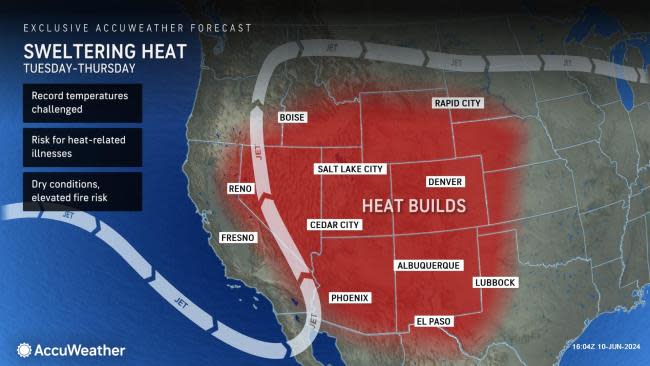Resurgence of heat to impact outdoor plans across the West
AccuWeather meteorologists say that the first widespread heat wave of the year will continue to scorch locations across the Southwest and interior Northwest this week, with temperatures soaring upwards of 100 degrees for days on end.
Late last week, numerous daily temperature records were shattered across the West as an early summer heat dome set up over the region. Over several days, a northward bulge in the jet stream helped pump very warm air in from the Four Corners to portions of Washington, Oregon and Idaho, and it will not cease just yet.
In places like Las Vegas, daytime highs soared up to 111 F on Thursday and 110 F again on Friday, setting new daily records both days.
 |
Residents are urged to drink plenty of fluids, wear lightweight and loose-fitting clothing and stay in air-conditioned rooms if possible. Monitor children and the elderly for signs of heat-related illnesses and aim to limit strenuous activity outdoors.
Additional records were broken farther north across Washington state. Places like Quillayute, Washington, observed temperatures approaching 80 degrees F, breaking the previous record of 74 F set back in 2015. For reference, typical early June temperatures for Quillayute fall into the lower 60s F.
A front pressing over Colorado and New Mexico into the Plains will keep a risk for showers and thunderstorms in place early this week. As the heat continues to plague the Southwest, locations from eastern Oregon to Idaho and Montana, will see the resurgence of heat from Tuesday to Thursday.
"Showers and thunderstorms will bring along some relief from the heat into early week, with a trend towards dry and hot conditions to follow through the remainder of the week out West," explained AccuWeather Meteorologist Brandon Buckingham.
 |
Area hikers and those enjoying an early summer camping trip will need to keep an eye to the sky if spending time outdoors early this week. Checking the forecast, monitoring radar and staying weather-aware can keep outdoor enthusiasts prepared in a pattern such as this. Experts warn that if you can hear thunder outdoors, you are close enough to the storm to be struck by lightning and should take shelter immediately.
Have the app? Unlock AccuWeather Alerts™ with Premium+
Along the coast in California, the heat dome over the West will have less of an influence compared to inland locations. The pattern will shift slightly by midweek; however, forecasters say that temperatures can gradually rise a few degrees.
"There can be some relief from the heat along the immediate California coast early in the upcoming week, but winds are expected to shift offshore into midweek, which can allow the heat to advance right into coastal communities," noted Buckingham.
Across the West this week, a resurge of heat is expected to occur from California to Colorado and New Mexico. Temperatures will once again climb several degrees higher than late-weekend values up to the 100s to 110s F, primarily for desert locations.
Buckingham added that places like Phoenix are projected to observe daytime highs at or above 110 degrees F by through at least midweek as a dome of high pressure anchors over the region.
Meanwhile, occasional, weak cold fronts pushing into the Pacific Northwest coast can allow for brief cooling periods.
 |
Some areas of the Four Corners will continue to face a high risk for wildfires to develop this week as the heat persists. Locations across Arizona and western New Mexico may miss out on any moisture from afternoon thunderstorms, further worsening the drought conditions.
Given the weather conditions this upcoming week, West Coast states will also face some risk of new wildfires igniting. Areas of central and eastern Washington, central Oregon through interior California will be a zone to monitor as the heat resurges across the region.
As a dip in the jet stream pushes inland over the West from the mid-to-late week, mainly dry thunderstorms could erupt over the Deserts and Great Basin. Where little rain falls with lightning strikes, the potential for wildfire ignition will increase significantly.
Want next-level safety, ad-free? Unlock advanced, hyperlocal severe weather alerts when you subscribe to Premium+ on the AccuWeather app. AccuWeather Alerts™ are prompted by our expert meteorologists who monitor and analyze dangerous weather risks 24/7 to keep you and your family safer.






